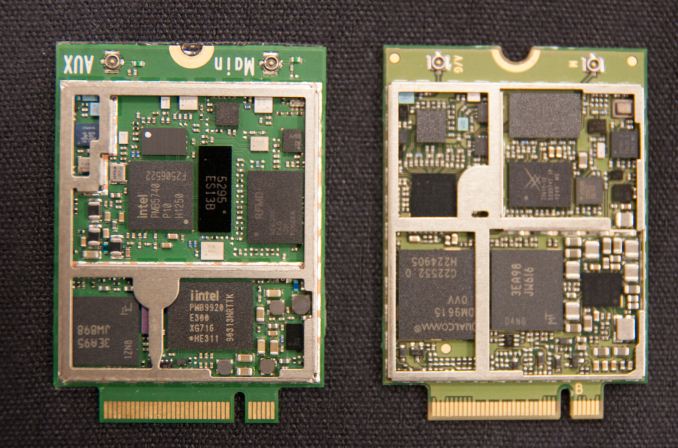Intel Announces PCIe M.2 LTE Modules with XMM7160, Notes Galaxy Tab 3 (10.1) Socket Win
by Brian Klug on October 30, 2013 10:35 AM EST_678x452.jpg)
Intel has been ramping up how much it's talking about its first available multimode LTE solution, XMM7160, which we've seen public disclosure of and talked about before. For those not familiar, Intel's XMM7160 is an LTE category 3 multimode (GSM, EDGE, DC-HSPA+) solution capable of covering 15 LTE bands.
Today, Intel noted that its XMM7160 solution in a multimode configuration is shipping in a commercial product, namely the Samsung Galaxy Tab 3 (10.1) in Europe and Asia. Getting a tier-1 socket win is a big deal for Intel, which had a lot of success with its 3G WCDMA parts (XMM6160 and XMM6260 were relatively ubiquitous) but only recently introduced a multimode LTE solution with XMM7160.
The other part of the news is the announcement of new PCI Express modules in the M.2 (previously NGFF) form factor for connecting tablets, 2 in 1 devices, and other mobile devices. I believe this is the card we got the chance to take a sneak peak of back during IDF 2013 alongside a comparable Qualcomm module with MDM9615. The M.2 form factor WWAN cards with XMM7160 also include Intel's CG1960 GNSS solution, which I believe was part of the ST-Ericsson portfolio of GNSS products that went to Intel with its acquisition earlier this year.
Alongside that announcement is a differently packaged transceiver, dubbed SMARTi m4G. This is a Murata packaged LTCC (low temperature co-fired ceramic) containing Intel's SMARTi 4G transceiver we've written about before and additional front end components. The ceramic package includes filters, duplexers, switches and matching, power amplifiers are still external however. Intel says this package reduces component count drastically and reduces implementation area by 100 square millimeters, or over 20 percent.
Finally Intel notes that its multimode XMM7260 LTE-Advanced, category 6 modem with carrier aggregation and both TDD-LTE and TD-SCDMA support will be coming sometime in 2014.
















10 Comments
View All Comments
akmittal - Wednesday, October 30, 2013 - link
It supports TD-2300?skiboysteve - Wednesday, October 30, 2013 - link
thanks for sharing. I'm curious of the power competitiveness of this compared to qualcomm solutions.does this do average power tracking or even better, envelope tracking? does Intel have a statement about that?
Andypro - Wednesday, October 30, 2013 - link
Brian: Thanks for adopting the singular possessive form for collective entities which reads nicely and is good, grammatically correct American English. You might think that no one would notice such tiny changes, but we do and they're appreciated.Either that or Anand secretly wrote or edited this. :)
speculatrix - Wednesday, October 30, 2013 - link
it we're going to start nit-picking... "transciever" -> "transceiver"Brian Klug - Wednesday, October 30, 2013 - link
Fixed, thanks!-Brian
Brian Klug - Wednesday, October 30, 2013 - link
It's definitely me writing these, but glad to hear it :)-Brian
aryonoco - Wednesday, October 30, 2013 - link
Quick! Brian is reading the comments! Let's talk about SD cards ;-)RU482 - Wednesday, October 30, 2013 - link
For Verizon or Sprint, is there a 3G fallback? Or is that even a concern anymore?DanNeely - Wednesday, October 30, 2013 - link
Verizon's the only operator in the US which is approaching 4g everywhere. Sprint is still roaming on VZW 3g outside of most cities/large towns.Penti - Wednesday, October 30, 2013 - link
Of course it does not only handle LTE, from the article "For those not familiar, Intel's XMM7160 is an LTE category 3 multimode (GSM, EDGE, DC-HSPA+)" That is actually 5-band HSPA+, 4-band GSM/EDGE. But that also means no CDMA for Verizon.